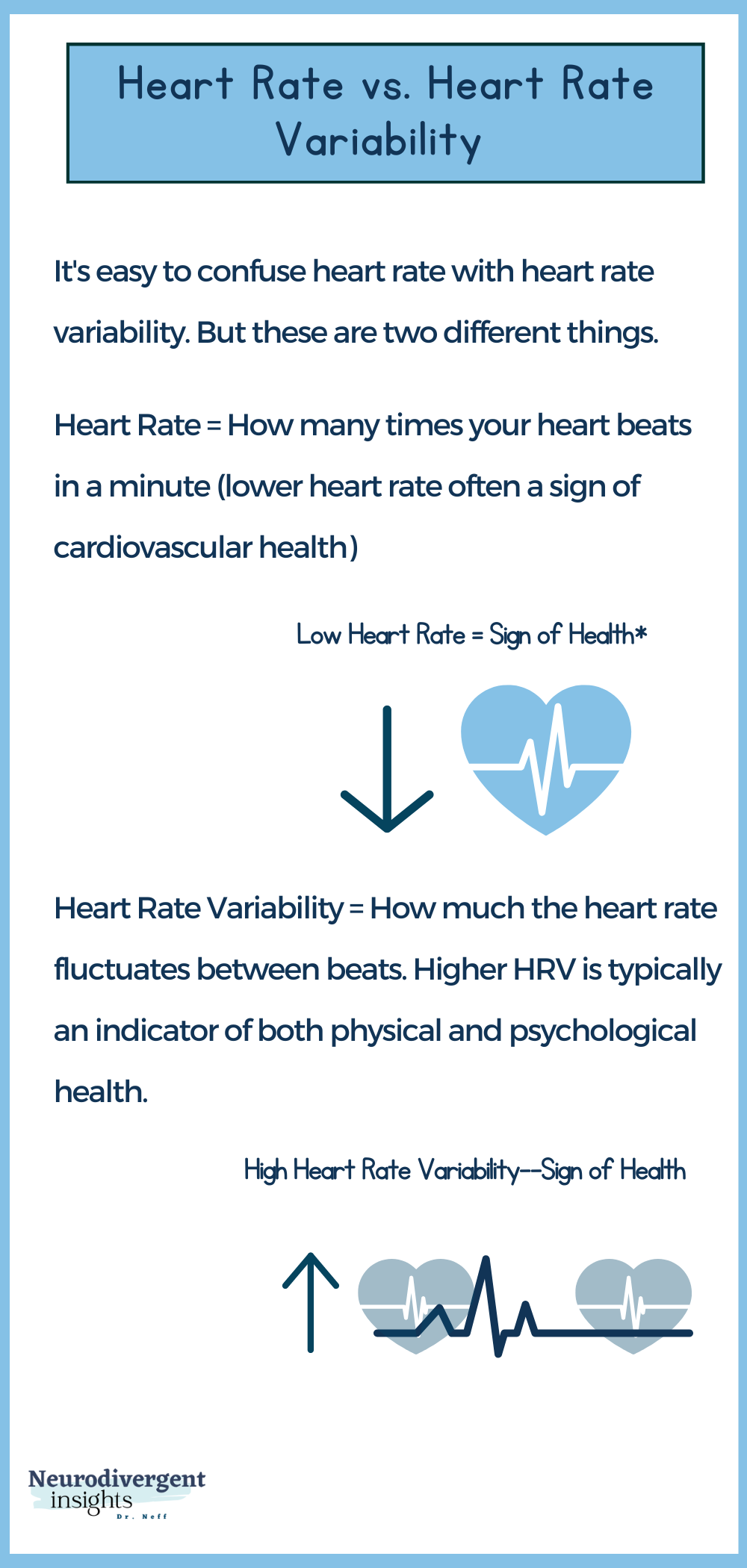What is HRV: The Importance of Heart Rate Variability
Do you ever feel like you become angry or shut down really easily? Maybe it’s difficult for you to stay present when you’re with other people, to listen, or to engage socially whatsoever. If something like this is true for you, you may have low heart rate variability (HRV). But what is HRV exactly?
I’m a neurodivergent clinician I am often working better to understand my own and my client's nervous systems. When we understand our nervous system and HRV, we are better able to make meaningful changes to take care of ourselves and heal.
In this article, I’m going to go over what HRV is and what it’s used for, what low HRV is associated with, and how to track yours.
What is Heart Rate Variability (HRV)?
HRV stands for heart rate variability. HRV is a measurement of how much variety there is in the heart’s rhythm. It’s important to note this isn’t the same thing as heart rate. Heart rate measures how frequently your heart beats in a given minute. While a low heart rate is typically associated with health, the opposite is true for heart rate variability. High heart rate variability is associated with strong health.
The higher the heart rate variability, the more flexibility the autonomic nervous system is working together. When the autonomic nervous system is working well together it can more easily adapt to incoming stressors and changes in the environment. This means that the higher the HRV, the more flexible and adaptable the nervous system is, which means we can respond more flexibly to incoming stressors.
What is HRV Used For?
HRV is a direct measurement of our vagal tone, which affects how large our window of tolerance is. The wider our window of tolerance and the higher our vagal tone, the more able we are to live life presently. When we feel grounded, engaged, open, and curious, that’s when we’re in our window of tolerance. When in this window, not only are we more present, but we’re also able the take on more stress, handle more change, and recover more quickly. However, when we exit the window of tolerance, we become dysregulated. In a state of dysregulation, we can feel anxious, fearful, foggy, shut down, fatigued, angry, and more. Therefore, the higher our HRV, the less prone we are to stress and emotional dysregulation. Learn more about the window or tolerance and vagal tone.
What is Low HRV Associated With?
Low heart rate variability is associated with several mental health and physical health conditions. Including the following:
Mental Health Conditions:
Anxiety
Stress
Depression
PTSD
Neurodivergent conditions (Schizophrenia, ADHD, Autism)
Physical Health Conditions:
Diabetes
Chronic pain
Concussion
Asthma
Insomnia
Fatigue
Inflammation
Dementia
Cardiovascular health
What is Your HRV?
Tracking your HRV is one way of monitoring your nervous system health and your window of tolerance. By tracking our HRV, we get to notice stress, anxiety, depression, and other nervous system patterns. HRV is a clear indicator of nervous system health. So how do you track it?
First, you will need heart rate monitors to tell you your HRV. These include Apple Watches and FitBits. Many of these programs have a way to track her HRV over time. After initiating lifestyle changes or nervous system practices aimed at increasing vagal tone/heart rate variability, you can monitor to see if you notice adjustments in your heart rate variability. This is how I recommend doing that: first, track your HRV before beginning these practices. Then, introduce HRV exercises and do them consistently for at least three months. At the end of that period, you may be able to see some HRV improvement. However, for the best result, I recommend doing this over the course of a year as HRV can be slow to change.
Summary: What is HRV?
HRV is a reliable indicator of nervous system health and function. It allows us to understand our window of tolerance and vagal tone so that we can better take care of our bodies, heal, and expand our capacity. Low HRV is associated with many mental and physical health conditions, such as anxiety, depression, PTSD, diabetes, high blood pressure, and more. by tracking your HRV, you get a window into your nervous system health and can more skillfully introduce practices into your life to help you heal.
There is so much to learn about the nervous system. If you’d like to learn more about the nervous system and ways you can help and grow in an educated way, check out my article on the neurodivergent nervous system. I also have a nervous system workbook available to purchase. In the workbook, you’ll get lots of information about the physiology of the nervous system, as well as a dozen workbook pages that will allow you to learn about yourself and grow.


